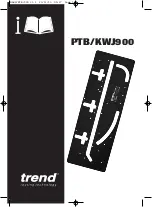
409-32048
Rev A
33
of 64
the PCB to clear the fixture when the PCB is conveyed. The conveyor will lift the PCB up 25 mm
[.98 in.]) before it conveys the PCB. This maximum height as measured from the fixture support plate
to the conveyor belt is 55 mm [2.17 in.]. Flatness and parallelism of top and bottom surfaces of the
fixture should have a maximum run-out of 0.13 mm [.005 in.].
—
Length
–
60 to 914.4 mm [2.40 to 36 in.].
—
Width
–
90 to 711.2 mm [3.5 to 28 in.].
—
Mounting -
The fixture is precisely located and orients the PCB relative to the “Origin” (0, 0) position
dowel in the fixture support plate. Any two of the dowel holes provided on the fixture support plate can
be used. However, the fixture must be located on the fixture support plate so that the front edge of the
PCB will align with the PCB stops in the conveyor rail.
—
Connector Support area -
The support fixture should be designed with maximum clearance possible
around the pin holes in the PCB. It should generally be a series of slots cut through the width of the
individual “support islands” or drilled holes.
The slots or holes should be as wide as possible, limited
only by the amount of contact area required to prevent marking or stressing the surface of the PCB.
—
PCB Clamping
–
The conveyor uses adjustable positioned clamp fingers to clamp the PCB down to
the fixture. This prevents the PCB from being lifted when an insertion tool is retracted from a pressed
connector. Also, the clamp holds the PCB flat to the fixture. The height of the clamp bar is adjusted so
it provides a small clearance of 1 mm [.03 in.] when the clamp bar is in the up position and the PCB is
being conveyed. PCB thickness range is 1.5 to 6 mm [.06 to .236 in.]. Alternate mounting of clamp
fingers allows thickness of 10 mm [.39 in.].
—
PCB Edge Clearance
–
The conveyor uses adjustable positioned clamp fingers to clamp the PCB
down to the fixture. The edge clearance on the top side of the PCB is 3 mm [.12 in.]; clearance on the
bottom side of the PCB is 6 mm [.236 in.]; this meets SMEMA specifications.
—
PCB Locating Method:
Provide self-centering on tapered locating pins of ø3-5 mm [.118-.197 in.].
PCB locating hole to pin clearance shall not exceed 0.25 mm [.010 in.].
Figure 35
—
Quick Facts:
(Figure 36)
Board handling:
Length:
60 to 914.4 mm [2.40 to 36 in.]
Width:
90 to 711.2 mm [3.54 to 28 in.]
Thickness:
1.5 to 6.5 mm [.06 to .256 in.]
Or
4 to 10 mm [.15 to .39 in.] with alternate clamps
PCB Weight:
16 kg [35 lbs] max
Board edge clearance: 3 mm [.118 in.] above (SMEMA)
6mm [.236 in.] below (SMEMA)
Above PCB clearance: 95 mm [3.75 in.) max; as measured from the conveyor belt in the up (convey)
position to the bottom surface of the tool bar in the tool holder on the head.
Allow clearance for PCB thickness plus components.
Below PCB clearance: 55 mm [2.17 in.]. Allow clearance for components on underside of PCB.
Sample Locating Pin















































